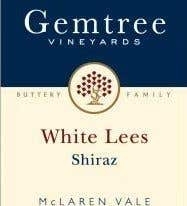From £19.99, $37, Aus$45 I believe we have a truly ground-breaking wine here. Mike Brown of Gemtree Vineyards in McLaren Vale is one of the scores if not hundreds of artisan winemakers in Australia and I have been impressed by many of his previous wines. Indeed his Bloodstone Shiraz 2003 was a wine of the week in 2005. While tasting my way through 100 current offerings from the revived UK chain Oddbins, I was impressed by the hand-picked nature of the Australians and, in particular, by Gemtree, White Lees Shiraz 2006 McLaren Vale. It seemed to be much more ‘natural’ than most Australian Shiraz, with real breadth and life to it. I gave it the unusually generous score of 17 points out of 20, thought it would drink well for the next three years at least, and wrote:
100% Shiraz with 5% Chardonnay lees. Screwcap. Residual Sugar 1.1 g/l
This is the first time I've come across a Shiraz aged on Chardonnay lees. But this seems to have worked, and indeed added stability and complexity. Very dark, sweet and powerful. Really zesty! I see this as a great discovery. No drying tannins on the finish. The wine seems extra luscious and interesting. 14.5%
£22.99 or £18.39 in a mixed case Oddbins, limited availability
This is a really very well balanced, complete wine, not at all like the disjointed style that Andrew Jefford berates in his recent lecture at Australia's National Wine Centre.
‘During barrel work toward the end of the 2004 vintage I had a "eureka" moment. While racking barrel fermented Chardonnay, I noticed an unusual intensity and freshness in the remaining lees. Most were taut yet fluffy, with a linear core of acid, plumped by a green apple crunch and softened with just a hint of creamy shortbread. Intriguing!
‘As winemakers we’re aware of how much intensity of flavour is trapped in lees. We’ve all noted that the inclusion of flocculating lees in a white ferment contributes to texture and depth of flavour, and how lees stirring in tank or barrel can do the same. After seeing the results of the 2004 experiment [of adding Shiraz to these Chardonnay lees] which is now long bottled and sold I wanted to have another crack. In 2005 the lees exhibited a slightly stressed character and we did not proceed with the trial.
‘In 2006 we were back on target! I used the same techniques as trialled in the 2004 vintage and placed the Shiraz on top of the freshly racked Chardonnay lees. I stirred the lees for the first four months to encourage more integration and left nature to do the rest. The 2006 took longer to integrate in bottle than the 2004 due to the nature of the vintage. The 2006s are generally showing more acid and tannin (due to the wet spring), while the 2004 was all opulence from the time of bottling.
‘Shiraz White Lees 2006 is taut but hints at the generosity kind cellaring will reveal. Blackcurrant, redcurrant, plum and anise are all in evidence on the palate, along with a hint of ginger stem from the lees component. It’s fascinating cracking a bottle and watching it open and reveal itself over the course of four or five days. The wine shows little evidence of oxidation and I think it will age exceptionally well. It’s fair to say that our White Lees is no longer an experiment! Gemtree will be producing White Lees in any year that we are gifted with exceptional Shiraz and I can find lees that suit.’
I asked Mike to compare the effect of white lees v red lees on a red wine.‘I have found the white (cf red) lees add other dimensions to the wine. Due to the entirely different structural characteristic of the two wines, I find the opposites attract – both from a preservation and aromatic/textural perspective. The acid and tartrates from the white increases the total acidity by 0.7-1.2g/l and conversely reduces the pH by 0.3-0.5.
‘The experiments I have done with Shiraz on Shiraz lees certainly work but not to the extent of the white lees. The Shiraz lees will assist with the textural aspects of the wine but not assist with the preservation.
‘Interestingly, the health of the lees is critical to the project working. The lees have to be fluffy and crunchy, not gluggy. If they are gluggy they will not have the same floral impacts and will detract from the vibrancy of the wine.’
According to wine-searcher.com, you can find the wine in the US and Australia as well as in the UK, at Cambridge Wine Merchants for £19.99 and Oddbins in the UK. For once, it’s cheaper in the UK than in the US and Australia.

